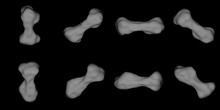216 Kleopatra
| Discovery | |
|---|---|
| Discovered by | Johann Palisa |
| Discovery date | April 10, 1880 |
| Designations | |
| A905 OA, A910 RA | |
| Main belt | |
| Orbital characteristics | |
| Epoch 30 January, 2005 (JD 2453400.5) | |
| Aphelion | 523.049 Gm (3.496 AU) |
| Perihelion | 312.544 Gm (2.089 AU) |
| 417.796 Gm (2.793 AU) | |
| Eccentricity | 0.252 |
| 1704.704 d (4.67 a) | |
Average orbital speed | 17.82 km/s |
| 55.259° | |
| Inclination | 13.136° |
| 215.672° | |
| 179.099° | |
| Physical characteristics | |
| Dimensions | 217 × 94 × 81 km |
| Mass | unknown |
Mean density | 3.5+ |
| 5.385 h | |
| Albedo | 0.116 |
| Temperature | unknown |
Spectral type | M |
| 7.3 | |
216 Kleopatra is a Main belt asteroid found by Johann Palisa on April 10, 1880 in Pola. It is named after Cleopatra, the Queen of Egypt.

Kleopatra is an unusual object. Its odd shape was revealed by adaptive optics on the ESO 3.6m telescope at La Silla. By bouncing radar signals off the asteroid, a team of astronomers at the Arecibo radio telescope in Puerto Rico were able to develop a more detailed computer model of its shape, which confirmed the dog-bone like shape. A favored explanation is that Kleopatra is a contact binary: two similarly-sized asteroids that have hit and stuck together instead of breaking apart.
Kleopatra is a fairly big asteroid, measuring 217 × 94 × 81 km. It is believed to be a loosely packed metallic object, based on its radar albedo.
Other websites
[change | change source]- Bilobated shape of 216 Kleopatra
- Astronomers Catch Images of Giant Metal Dog Bone Asteroid – NASA article
- An Asteroid for the Dogs Archived 2004-02-28 at the Wayback Machine
References
[change | change source]- The Asteroid Orbital Elements Database[permanent dead link]
- Minor Planet Discovery Circumstances
- Asteroid Lightcurve Data FileArchived 2010-07-20 at the Wayback Machine
